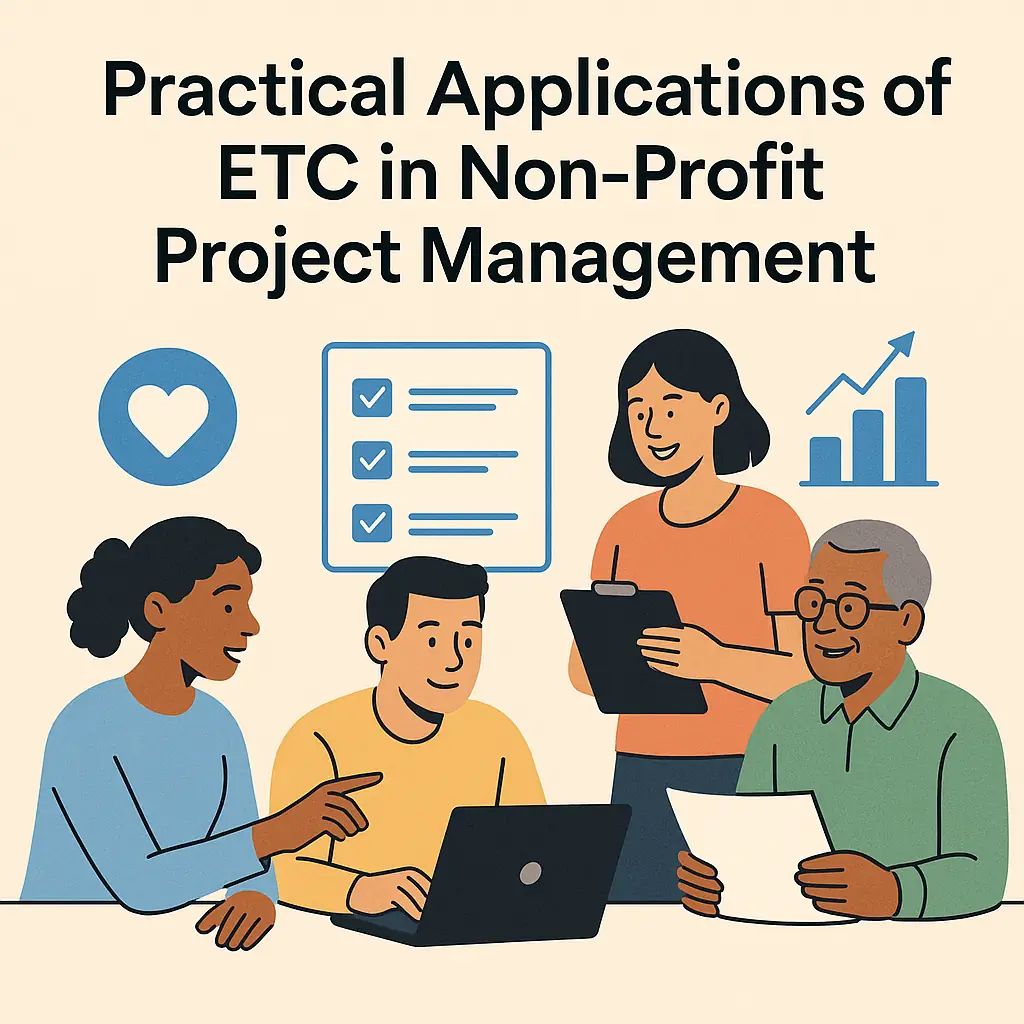Introduction to ETC in Project Management
Particularly within non-profit organizations, the concept of Estimate to Complete (ETC) plays a pivotal role in ensuring projects are completed on time and within budget. Understanding ETC is essential for non-profit project managers who aim to maximize their resources and achieve their mission effectively.
Definition of Estimate to Complete (ETC)
Estimate to Complete (ETC) is a forecasting technique that provides an approximation of the costs required to finish the remaining work on a project. It is calculated by assessing the costs incurred to date and estimating the additional funds needed to complete the project. This metric is crucial as it allows project managers to monitor financial health and make informed decisions regarding resource allocation and budget management. By regularly updating the ETC, non-profit organizations can detect areas of overspending and adjust their strategies accordingly, ultimately preventing budget overruns and ensuring project success [3][15].
Role of ETC in Project Management Methodologies
ETC is integral to various project management methodologies, including Earned Value Management (EVM). In EVM, ETC is used alongside other metrics such as Estimate at Completion (EAC) and Budget at Completion (BAC) to provide a comprehensive view of a project’s financial status. The relationship between these metrics is defined by the formula: EAC = Actual Cost of Work Performed (ACWP) + ETC. This relationship helps project managers understand the financial implications of their current progress and forecast future costs more accurately [12][11].
Incorporating ETC into project management practices enables non-profit organizations to set realistic goals and expectations, facilitating better communication with stakeholders and team members. By utilizing ETC, project managers can create a dynamic budget that reflects the project’s evolving needs, ensuring that resources are allocated efficiently and effectively [9][10].
Unique Challenges Faced by Non-Profit Organizations in Project Management
Non-profit organizations often encounter distinct challenges in project management that can complicate the application of ETC. These challenges include:
- Limited Resources: Non-profits typically operate with constrained budgets and personnel, making it essential to manage costs meticulously. The accurate calculation of ETC helps in identifying potential financial shortfalls before they become critical issues [2][15].
- Diverse Funding Sources: Non-profits often rely on multiple funding sources, each with its own reporting requirements and timelines. This complexity necessitates a clear understanding of ETC to ensure that all financial obligations are met without jeopardizing project outcomes [8].
- Stakeholder Expectations: Non-profits must balance the expectations of various stakeholders, including donors, beneficiaries, and community members. By effectively utilizing ETC, project managers can provide transparent updates on project progress and financial health, fostering trust and support from stakeholders [9].
Understanding the Components of ETC
Particularly within non-profit organizations, the Estimate to Complete (ETC) serves as a vital forecasting tool that helps project managers predict the costs required to finish a project. By understanding the components that contribute to calculating ETC effectively, non-profit project managers can enhance their budgeting accuracy and project outcomes.
The Formula for Calculating ETC
The formula for calculating the Estimate to Complete is straightforward yet powerful:
ETC = EAC – AC
- ETC (Estimate to Complete): This represents the anticipated costs needed to complete the remaining work of a project. It is crucial for non-profits to have a clear understanding of this figure to allocate resources effectively and avoid budget overruns [10].
- EAC (Estimate at Completion): This is an independent forecast of the total cost of the project at its completion. It takes into account the actual costs incurred to date and the projected costs to finish the project. EAC is calculated by summing the cumulative Actual Cost of Work Performed (ACWP) and the Estimate to Complete (ETC) [10][11].
- AC (Actual Cost): This refers to the total costs that have been incurred for the work completed up to the current point in the project. Accurate tracking of AC is essential, as it directly influences the EAC and, consequently, the ETC [10].
The Importance of Accurate Data Collection
Accurate data collection is paramount for effective ETC calculations. The reliability of the ETC depends on the precision of the inputs used in its calculation. Here are some key aspects to consider:
- Regular Updates: ETC should be recalculated regularly as the project progresses. This dynamic nature allows project managers to adjust their forecasts based on the most current data, which is particularly important in the non-profit sector where funding and resources can fluctuate [13].
- Identifying Cost Drivers: By closely monitoring actual costs and comparing them against the budget, project managers can identify areas of overspending or inefficiencies. This proactive approach helps in making informed decisions to mitigate risks and manage costs effectively [3][15].
- Utilizing Historical Data: Leveraging historical data from previous projects can enhance the accuracy of ETC calculations. Understanding past performance can provide insights into potential future costs and help in setting realistic expectations for new projects [12].
Benefits of Using ETC in Non-Profit Project Management
The Effective Time and Cost (ETC) methodology can serve as a powerful tool to enhance project outcomes. By focusing on the unique challenges faced by non-profits, the implementation of ETC can lead to significant improvements in various aspects of project management. Here are some key benefits:
- Facilitate Better Budget Management and Financial Forecasting: ETC allows non-profit organizations to gain a clearer understanding of their financial status throughout the project lifecycle. By accurately estimating the remaining costs and time required to complete a project, non-profits can make informed decisions about budget adjustments and resource allocation. This proactive approach helps in avoiding budget overruns and ensures that funds are utilized effectively, which is crucial for organizations that often operate with limited financial resources.
- Improve Resource Allocation and Project Prioritization: Non-profits frequently juggle multiple projects with varying degrees of urgency and importance. ETC provides a framework for assessing the remaining work and associated costs, enabling project managers to prioritize tasks based on their impact and resource requirements. This strategic allocation of resources ensures that critical projects receive the attention they need, ultimately leading to more successful outcomes and a greater impact on the community served.
- Enhance the Ability to Communicate Project Status to Stakeholders: Transparency is vital in non-profit project management, especially when it comes to communicating with stakeholders, including donors, board members, and community partners. ETC offers a clear and objective basis for reporting project progress, allowing project managers to present accurate updates on timelines and budgets. This not only builds trust with stakeholders but also fosters a collaborative environment where everyone is informed and engaged in the project’s success.
Practical Steps for Implementing ETC in Non-Profit Projects
Effective project management is crucial for non-profit organizations to achieve their mission-driven goals. One of the key concepts in project management is the Estimate to Complete (ETC), which helps project managers forecast the remaining costs and time needed to complete a project. Here are actionable steps for non-profit project managers to integrate ETC into their project management practices:
- Establish a Baseline Budget and Timeline for Projects: Before initiating any project, it is essential to set a clear baseline budget and timeline. This serves as a reference point against which all future project performance can be measured. By defining these parameters upfront, non-profit managers can better assess the project’s progress and make informed decisions regarding resource allocation and adjustments as needed. A well-defined baseline allows for more accurate ETC calculations later in the project lifecycle [4][10].
- Regularly Track Project Progress and Costs to Update ETC Calculations: Continuous monitoring of project progress and expenditures is vital. Non-profit managers should implement a system for tracking key performance indicators (KPIs) related to both time and cost. By regularly updating the ETC calculations based on the latest data, managers can gain insights into whether the project is on track or if adjustments are necessary. This proactive approach helps in identifying potential issues early, allowing for timely interventions to keep the project aligned with its goals [10][13].
- Incorporate ETC into Routine Project Reviews and Stakeholder Reports: Integrating ETC into regular project reviews and reports to stakeholders enhances transparency and accountability. By presenting updated ETC figures during these reviews, non-profit managers can provide stakeholders with a clear understanding of the project’s financial health and timeline. This practice not only fosters trust among stakeholders but also encourages collaborative problem-solving when challenges arise. Regular communication about ETC can help ensure that everyone involved is aligned and informed about the project’s status [12][14].
Common Challenges and Solutions When Using ETC
Effective project management is crucial for non-profit organizations, particularly when it comes to utilizing Earned Value Management (EVM) techniques like Estimate to Complete (ETC). However, non-profits often face unique challenges that can hinder the successful application of ETC. Below are some common issues and strategies to overcome them.
1. Lack of Accurate Data
One of the primary challenges in using ETC is the reliance on accurate data for effective forecasting. Non-profits may struggle with data collection due to limited resources, lack of standardized processes, or insufficient documentation practices. This can lead to inaccurate estimates, which ultimately affect project outcomes.
Solutions:
- Implement Standard Operating Procedures (SOPs): Establishing clear SOPs for data collection and reporting can help ensure consistency and accuracy. This includes defining what data needs to be collected, how it should be recorded, and who is responsible for it [5].
- Utilize Technology: Leveraging project management software can streamline data collection and improve accuracy. Tools like Trello or other project management platforms can facilitate better tracking of project progress and resource allocation [1].
2. Resistance to Change
Introducing ETC into project management practices may meet resistance from team members who are accustomed to traditional methods. This resistance can stem from a lack of understanding of the benefits of ETC or fear of the unknown.
Solutions:
- Engage Stakeholders Early: Involve team members in the decision-making process when implementing ETC. By explaining the benefits and how it can improve project outcomes, you can foster a sense of ownership and reduce resistance [10].
- Communicate Clearly: Regular communication about the changes and their expected impact can help alleviate concerns. Providing clear examples of how ETC can lead to better project management can also encourage buy-in [12].
3. Importance of Continuous Training and Development
The effective use of ETC requires ongoing training and development. Non-profit organizations often have limited budgets and may not prioritize training, which can lead to a skills gap among team members.
Solutions:
- Invest in Training Programs: Allocate resources for training sessions focused on ETC and EVM principles. This can include workshops, online courses, or mentorship programs to enhance team members’ skills [14].
- Encourage a Learning Culture: Foster an environment where continuous learning is valued. Encourage team members to share knowledge and experiences related to ETC, which can help build a more competent and confident team [15].
By addressing these common challenges and implementing the suggested solutions, non-profit project managers can effectively utilize ETC to enhance project outcomes. This proactive approach not only improves data accuracy and team engagement but also contributes to the overall success of the organization’s mission.
Conclusion: The Future of ETC in Non-Profit Project Management
The concept of Earned Value Management (EVM) and its component, Estimate to Complete (ETC), plays a crucial role in ensuring project success. By effectively utilizing ETC, non-profit organizations can gain a clearer understanding of their project’s financial health and progress, which is essential for maintaining accountability and transparency to stakeholders. Here are some key takeaways regarding the importance of ETC in non-profit project management:
- Importance of ETC for Project Success: ETC provides project managers with a forecast of the remaining costs needed to complete a project. This insight is vital for non-profits, which often operate under tight budgets and limited resources. By accurately estimating the costs to complete a project, organizations can make informed decisions, allocate resources more effectively, and avoid potential financial pitfalls that could jeopardize their mission and objectives [5].
- Encouraging Ongoing Learning and Adaptation: The landscape of project management is constantly evolving, and non-profit project managers must be willing to learn and adapt their practices. Embracing ETC as a standard practice can lead to improved project outcomes and greater efficiency. Non-profits should invest in training and development opportunities that focus on project management methodologies, including the application of ETC, to enhance their team’s skills and knowledge [1][10].
In conclusion, the future of ETC in non-profit project management looks promising. By recognizing its importance, committing to ongoing learning, and fostering a community of shared experiences, non-profit organizations can leverage ETC to enhance their project management practices and ultimately achieve their missions more effectively.
Find out more about Shaun Stoltz https://www.shaunstoltz.com/about/.
This post was written by an AI and reviewed/edited by a human.



